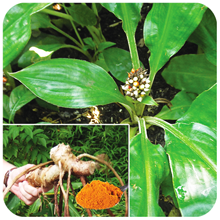
Curcuma longa (Turmeric) is an herbaceous plant of Asian origin, related to ginger and cultivated in India, southern China, Taiwan, Japan, Indonesia, Africa. It is an herbaceous plant, 60-90 cm tall with long lanceolate leaves having light green color. Yellowish white flowers appear on a stem with a spike. On the top of spike, white or pinkish white bracts give the impression of a flower with many large petals. It does not produce viable seeds. Plant needs temperatures between 20°C-30° C. Turmeric is used in Indian cuisine as a condiment with a pungent- bitter, aromatic taste. The rhizome of the plant is used medicinally.
Chemical composition – Rhizome of turmeric contains essential oils, sesquiterpenes (alpha and beta turmerone, alpha-curcumen, zinziberen), monoterpenes, a yellow pigment, named curcumin (5%), minerals, water-soluble peptide (turmerium peptide) and polysaccharides.
Properties – Cholagogue, choleretic, powerful detoxifier, antimutagenic, antitumor, anti-inflammatory, hepato-protective, antioxidant, antibiotic, antibacterial, antiviral, improves circulation, antiatherosclerotic, antithrombotic antiplatelet, cardioprotective, purifies blood, hypocholesterolemic, sustains joints, tendons mobility, antiinflammatory, febrifuge, soothes cough, sore throat, hemostatic, wound healer etc.
Recommendation – Circulatory disorders, bruising, sprains, sore muscles, hepatobiliary disorders, flatulence, jaundice, bleeding, ulcerative colitis, rheumatoid arthritis, respiratory infections, tumors, other rheumatic diseases.
This plant is incorporated in natural remedies ARTRISALM, DAITAB, KAMAIANY.




